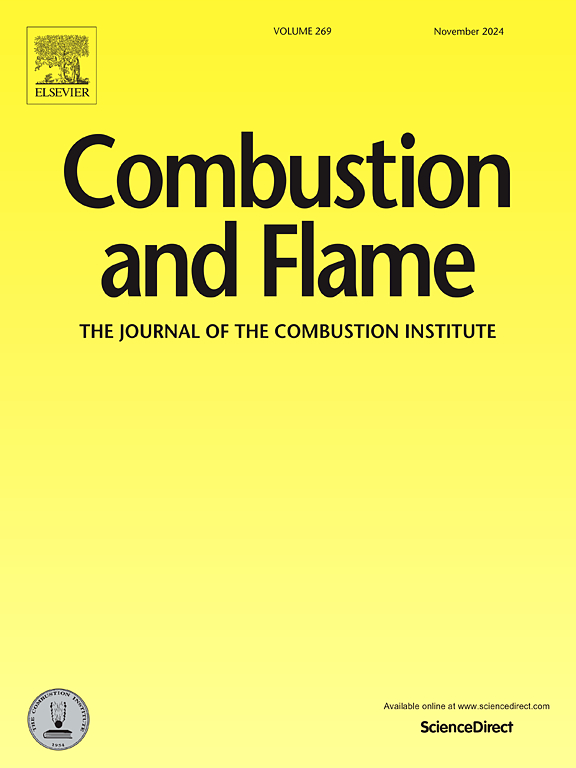Advancing the C4 low-temperature oxidation chemistry through species measurements in a rapid compression machine. Part B: n-Butane
IF 5.8
2区 工程技术
Q2 ENERGY & FUELS
引用次数: 0
Abstract
Studying the oxidation of n-butane, a major component of LNG, is critical to improve the efficiency of transportation engines. Furthermore, its negative temperature coefficient (NTC) behavior provides insights into the oxidation of larger hydrocarbons. Several studies have investigated n-butane oxidation at engine-operating pressures using various methods, including ignition delay time (IDT) measurements in rapid compression machines (RCMs) and shock tubes, flame velocities, and species concentrations in flow reactors. While these species measurements provide deeper insights into oxidation networks than IDTs, they are limited to either low-pressure or highly diluted conditions. To address this gap, this study measures species concentrations during n-butane oxidation at 30 bar in the NTC region (742 K and 855 K, respectively), at stoichiometric and moderate dilution levels in an RCM. A novel two-valve setup allowed gas sample extraction for off-line gas chromatography-mass spectrometry analysis. Complementary IDT data were obtained in the temperature range of K, at pressures of 15 and 30 bar, and equivalence ratios of 0.5, 1.0, and 2.0. The results suggest that while current n-butane models reasonably predict its autoignition characteristics, they fall short in predicting the formation of key oxidation intermediates at engine-relevant conditions. In this context, the n-butane submechanism within the NUIGMech1.3 framework was updated. Modifications involve recently computed thermochemical data for critical intermediates and adjustments to rate constants, using analogies with structurally similar molecules such as n-propane and n-pentane. The present model reproduces reasonably well both the measured IDT and species concentrations documented herein and data from the literature. Nevertheless, the model slightly underestimates the reactivity within the NTC domain and the formation of some intermediates at the NTC peak. This study highlights the importance of integrating species concentration and IDT measurements at application-relevant conditions to refine kinetic mechanisms and significantly advances the understanding of C hydrocarbon oxidation chemistry.
Novelty and Significance Statement
The novelty of this research lies in the measurement of species concentrations during the ignition delay of n-butane mixtures in an RCM at high pressures near the NTC minimum and maximum using a novel two-valve gas sampling setup. This, in combination with new thermochemical data and rate rules based on analogies with propane and n-pentane, allowed the refinement of the n-butane sub-mechanism within the NUIGMech1.3 framework.
By combining species concentration measurements with ignition delay times in the RCM, this study examines the oxidation of n-butane, a major component of LPG, under conditions that closely mimic engine environments, overcoming the limitations of previous studies limited to highly dilute conditions. This research is part of a broader investigation of C oxidation chemistry, along with our companion work on 1-butene. The resulting kinetic model is capable of reproducing most of the available n-butane and 1-butene validation targets.
求助全文
约1分钟内获得全文
求助全文
来源期刊

Combustion and Flame
工程技术-工程:化工
CiteScore
9.50
自引率
20.50%
发文量
631
审稿时长
3.8 months
期刊介绍:
The mission of the journal is to publish high quality work from experimental, theoretical, and computational investigations on the fundamentals of combustion phenomena and closely allied matters. While submissions in all pertinent areas are welcomed, past and recent focus of the journal has been on:
Development and validation of reaction kinetics, reduction of reaction mechanisms and modeling of combustion systems, including:
Conventional, alternative and surrogate fuels;
Pollutants;
Particulate and aerosol formation and abatement;
Heterogeneous processes.
Experimental, theoretical, and computational studies of laminar and turbulent combustion phenomena, including:
Premixed and non-premixed flames;
Ignition and extinction phenomena;
Flame propagation;
Flame structure;
Instabilities and swirl;
Flame spread;
Multi-phase reactants.
Advances in diagnostic and computational methods in combustion, including:
Measurement and simulation of scalar and vector properties;
Novel techniques;
State-of-the art applications.
Fundamental investigations of combustion technologies and systems, including:
Internal combustion engines;
Gas turbines;
Small- and large-scale stationary combustion and power generation;
Catalytic combustion;
Combustion synthesis;
Combustion under extreme conditions;
New concepts.
 求助内容:
求助内容: 应助结果提醒方式:
应助结果提醒方式:


